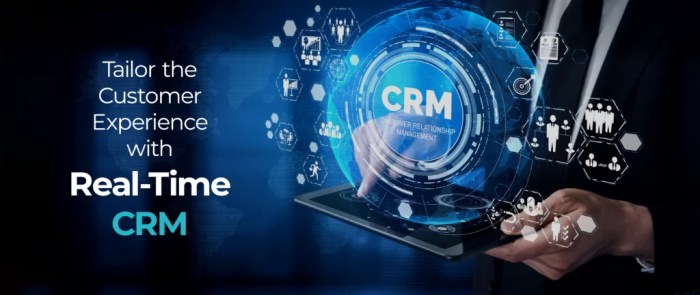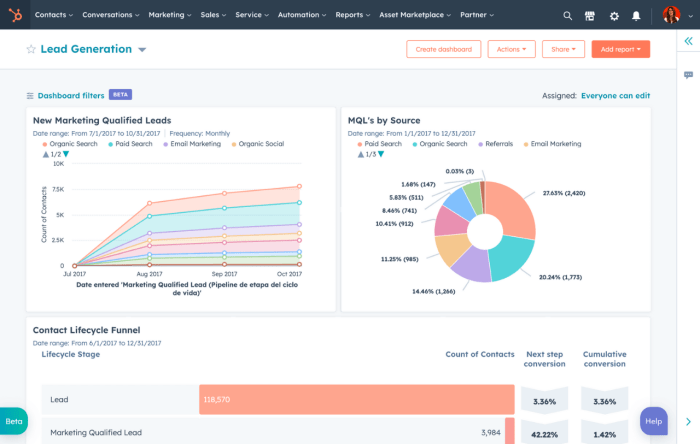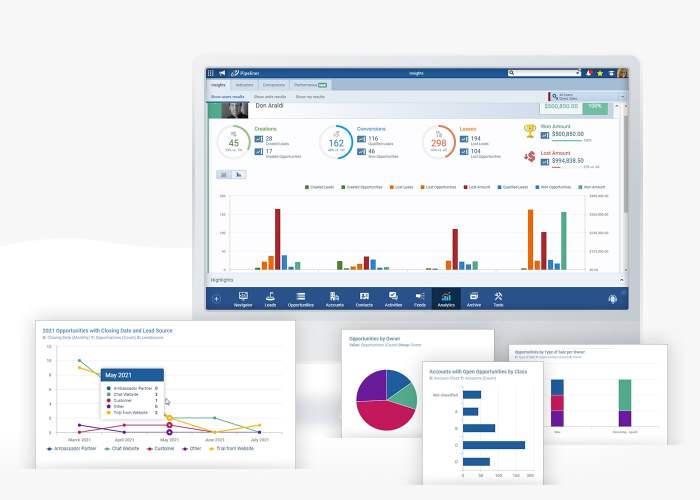CRM software for real-time reporting and insights revolutionizes business decision-making. By providing immediate access to crucial data, businesses gain a dynamic understanding of their performance, customer behavior, and market trends. This allows for proactive adjustments, improved efficiency, and ultimately, enhanced profitability. This exploration delves into the core components of real-time CRM reporting, highlighting its advantages over traditional methods and showcasing how effective data visualization contributes to sharper, faster decisions.
We’ll examine various data sources and integration strategies, emphasizing the importance of data accuracy and security. Furthermore, we will discuss analytical techniques for interpreting real-time trends, the role of predictive analytics, and the critical considerations for choosing the right CRM software to support real-time capabilities. The goal is to equip readers with a comprehensive understanding of how to leverage real-time CRM data for significant business gains.
Real-Time Reporting in CRM: Unveiling Actionable Insights

In today’s fast-paced business environment, access to real-time data is paramount. CRM software offering real-time reporting and insights empowers businesses to make data-driven decisions swiftly, enhancing operational efficiency and boosting overall performance. This article delves into the intricacies of real-time CRM reporting, covering its definition, benefits, implementation, analysis, and security considerations.
Defining Real-Time Reporting in CRM

Real-time CRM reporting provides immediate access to updated customer data, allowing businesses to monitor key performance indicators (KPIs) and operational metrics as they occur. This contrasts sharply with traditional reporting, which often relies on batch processing and delayed data updates, leading to potentially outdated information and slower decision-making.
Core components include a robust data integration system, a powerful reporting engine capable of handling high data volumes, and a user-friendly dashboard for visualizing key metrics. Immediate data access allows businesses to respond to emerging trends and customer needs in real-time, leading to improved customer satisfaction and increased revenue.
Compared to traditional reporting, which often involves scheduled reports with delays of hours or even days, real-time reporting offers unparalleled agility. Businesses can track KPIs such as sales conversions, customer churn rate, and marketing campaign effectiveness with minimal latency. Examples of real-time KPIs include website traffic, lead generation, sales pipeline progress, customer service response times, and social media engagement.
| Report Type | Data Source | Use Case | Benefits |
|---|---|---|---|
| Sales Pipeline Report | Sales CRM module, marketing automation | Monitor deal progress, identify bottlenecks, forecast revenue | Improved sales forecasting, proactive sales management |
| Customer Service Performance Report | Support ticketing system, CRM customer interaction logs | Track resolution times, identify areas for improvement in customer support | Enhanced customer satisfaction, reduced support costs |
| Marketing Campaign Performance Report | Marketing automation platform, CRM lead tracking | Measure campaign effectiveness, optimize marketing spend | Increased ROI on marketing campaigns, improved targeting |
| Website Traffic and Lead Generation Report | Website analytics, CRM lead capture forms | Analyze website performance, identify high-converting content | Improved website optimization, increased lead generation |
Data Sources and Integration for Real-Time Insights
Real-time CRM reporting relies on the seamless integration of diverse data sources. Common sources include sales and marketing automation platforms, customer support ticketing systems, e-commerce platforms, and social media analytics tools. However, integrating these disparate sources presents challenges, including data format inconsistencies, data security concerns, and maintaining data integrity across various systems.
APIs and data connectors play a crucial role in facilitating the real-time flow of data. APIs allow different systems to communicate and exchange data automatically, while data connectors simplify the integration process by providing pre-built connections between various platforms. A well-designed workflow diagram would illustrate the data movement from each source, through data transformation and cleansing processes, to the CRM dashboard.
Best practices for ensuring data accuracy and consistency involve implementing data validation rules, regularly auditing data quality, and using data governance frameworks to maintain data integrity. Data normalization and standardization are crucial steps to ensure consistent data representation across different systems.
Visualizing Real-Time Data for Effective Decision-Making
Effective data visualization is crucial for transforming raw data into actionable insights. Interactive dashboards provide a dynamic view of key metrics, enabling quick identification of trends and anomalies. The use of interactive dashboards significantly enhances decision-making speed by presenting critical information in a clear and concise manner.
- Sales Trends: Line charts, area charts
- Customer Segmentation: Pie charts, bar charts
- Support Ticket Resolution Times: Histograms, scatter plots
- Marketing Campaign Performance: Bar charts, funnel charts
Different dashboard design approaches, such as the use of color-coding, interactive elements, and customizable views, can significantly impact the user experience. A well-designed dashboard should prioritize user-friendliness, ensuring that critical information is easily accessible and understandable.
Analyzing Real-Time Trends and Patterns, CRM software for real-time reporting and insights
Real-time CRM data can be analyzed using various statistical methods, including trend analysis, correlation analysis, and anomaly detection. However, it’s important to acknowledge potential biases, such as sampling bias or selection bias, which can affect the accuracy of the analysis. Strategies for identifying and responding to emerging trends involve setting up real-time alerts, implementing automated workflows, and utilizing predictive analytics.
Predictive analytics plays a crucial role in improving business outcomes by forecasting future performance based on historical data and current trends. For instance, by analyzing real-time sales data, businesses can predict future demand and optimize inventory management. Similarly, analyzing customer behavior data can help predict churn risk and allow for proactive intervention.
Security and Privacy Considerations for Real-Time CRM Data
Protecting real-time CRM data requires robust security measures, including data encryption, access control mechanisms, and regular security audits. Compliance with data privacy regulations, such as GDPR and CCPA, is crucial for handling sensitive customer data responsibly. Data governance frameworks, including clear data ownership and access policies, are essential for ensuring data security and compliance.
Potential risks associated with real-time data breaches include financial losses, reputational damage, and legal penalties. Secure data transmission methods, such as HTTPS and VPNs, are necessary to protect data during transmission. Regular security assessments and penetration testing can help identify and mitigate vulnerabilities.
Choosing the Right CRM Software for Real-Time Capabilities
Selecting a CRM platform with robust real-time reporting capabilities is crucial for maximizing the benefits of real-time data analysis. Various CRM platforms offer different features and functionalities, and careful evaluation is necessary to choose the best fit for specific business needs.
| CRM System | Real-Time Reporting Capabilities | Data Visualization Tools | Integration Options | Pricing |
|---|---|---|---|---|
| Salesforce Sales Cloud | Real-time dashboards, custom reports, and analytics | Variety of charts, graphs, and dashboards | Extensive API and integration options | Subscription-based, varying by features and users |
| Microsoft Dynamics 365 | Real-time dashboards, interactive reports, and Power BI integration | Interactive dashboards and Power BI visualizations | Integrates with Microsoft ecosystem and other platforms | Subscription-based, varying by features and users |
| HubSpot CRM | Real-time dashboards, reporting on key metrics | Built-in dashboards and reporting tools | Integrates with various marketing and sales tools | Freemium model, paid plans for advanced features |
| Zoho CRM | Real-time dashboards and reporting | Customizable dashboards and reporting options | Integrates with Zoho’s suite of applications and other platforms | Subscription-based, varying by features and users |
Key factors to consider include the platform’s scalability, its ability to integrate with existing systems, the availability of real-time dashboards and reporting tools, and the overall cost of ownership. A checklist for evaluating CRM software should include assessing the platform’s real-time reporting capabilities, data visualization options, integration options, security features, and user-friendliness.
Concluding Remarks: CRM Software For Real-time Reporting And Insights

In conclusion, harnessing the power of CRM software for real-time reporting and insights empowers businesses to operate with unprecedented agility and foresight. By effectively integrating data sources, visualizing key performance indicators, and implementing robust security measures, organizations can transform raw data into actionable intelligence. This allows for proactive responses to emerging trends, improved customer relationships, and ultimately, a significant competitive advantage in today’s dynamic marketplace.
The journey towards data-driven decision-making is not without its challenges, but the rewards of real-time insights are undeniable.
General Inquiries
What are the potential downsides of real-time CRM reporting?
While beneficial, real-time reporting can present challenges such as data overload, the need for robust IT infrastructure, and potential for increased complexity in data management. Careful planning and selection of appropriate software are crucial.
How can I ensure data accuracy in my real-time CRM reports?
Data accuracy is paramount. This involves implementing data validation processes, regular data cleansing, and using reliable data sources. Choosing a CRM with robust data integration capabilities is also essential.
What is the cost of implementing a real-time CRM system?
Costs vary significantly depending on the chosen CRM platform, the number of users, required integrations, and customization needs. It’s crucial to obtain detailed pricing information from potential vendors.
How do I choose the right KPIs to track in real-time?
Prioritize KPIs directly aligned with your business goals. Consider factors like sales conversion rates, customer churn, customer satisfaction, and marketing ROI. Start with a few key metrics and expand as needed.
